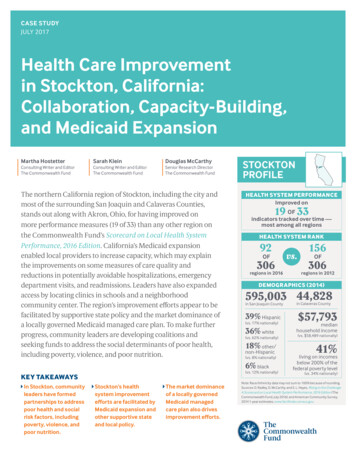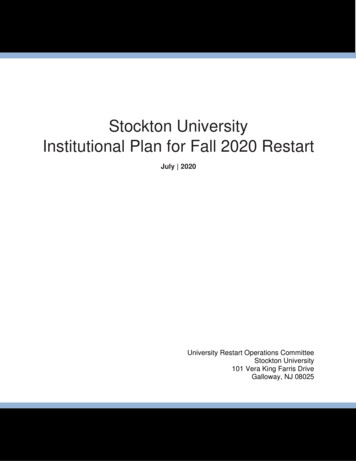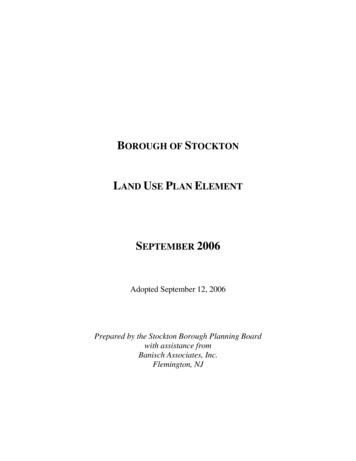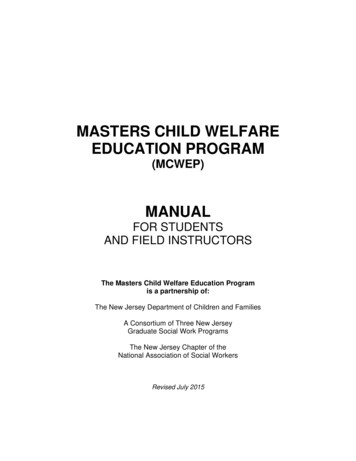
Transcription
CASE STUDYJULY 2017Health Care Improvementin Stockton, California:Collaboration, Capacity-Building,and Medicaid ExpansionMartha HostetterSarah KleinDouglas McCarthyConsulting Writer and EditorThe Commonwealth FundConsulting Writer and EditorThe Commonwealth FundSenior Research DirectorThe Commonwealth FundThe northern California region of Stockton, including the city andmost of the surrounding San Joaquin and Calaveras Counties,stands out along with Akron, Ohio, for having improved onmore performance measures (19 of 33) than any other region onthe Commonwealth Fund’s Scorecard on Local Health SystemPerformance, 2016 Edition. California’s Medicaid expansionenabled local providers to increase capacity, which may explainthe improvements on some measures of care quality andreductions in potentially avoidable hospitalizations, emergencydepartment visits, and readmissions. Leaders have also expandedaccess by locating clinics in schools and a neighborhoodcommunity center. The region’s improvement efforts appear to befacilitated by supportive state policy and the market dominance ofa locally governed Medicaid managed care plan. To make furtherprogress, community leaders are developing coalitions andseeking funds to address the social determinants of poor health,including poverty, violence, and poor nutrition.STOCKTONPROFILEHEALTH SYSTEM PERFORMANCEImproved on19HEALTH SYSTEM RANK92OF306regions in 2016I n Stockton, communityleaders have formedpartnerships to addresspoor health and socialrisk factors, includingpoverty, violence, andpoor nutrition. he market dominanceTof a locally governedMedicaid managedcare plan also drivesimprovement efforts.156OF306regions in 2012595,003 44,828in San Joaquin County39% Hispanic(vs. 17% nationally)36% white(vs. 62% nationally)18% other/non-Hispanic(vs. 8% nationally)(vs. 12% nationally) tockton’s healthSsystem improvementefforts are facilitated byMedicaid expansion andother supportive stateand local policy.vs.DEMOGRAPHICS (2014)6% blackKEY TAKEAWAYS33OFindicators tracked over time —most among all regionsin Calaveras County 57,793medianhousehold income(vs. 58,489 nationally)41%living on incomesbelow 200% of thefederal poverty level(vs. 34% nationally)Note: Race/ethnicity data may not sum to 100% because of rounding.Sources: D. Radley, D. McCarthy, and S. L. Hayes, Rising to the Challenge:A Scorecard on Local Health System Performance, 2016 Edition (TheCommonwealth Fund, July 2016); and American Community Survey,2014 1-year estimates, www.factfinder.census.gov.
Health Care Improvement in Stockton, California: Collaboration, Capacity-Building, and Medicaid Expansion2BACKGROUNDThis case study is part of a series exploring the factorsThe city of Stockton, home to more than 302,000 residentsthat may contribute to improved regional health systemand the seat of San Joaquin County in northern California,made headlines when its leaders filed for bankruptcyafter the 2008 housing crash and for leading the nationin foreclosures — both the consequences of overbuildingand overspending. While the city has recovered somewhatfrom the economic downturn, the social problems thatpreceded it have persisted. More than 40 percent ofresidents live at or below twice the poverty level.1 One offour students drops out of high school, and many workingage adults cannot find employment.2 Stockton also hasthe highest crime rate of any major metropolitan area inCalifornia and one of the highest per capita homicide ratesin the nation.3Stockton is shaped by its geography, with an economyperformance. It describes how leaders of Stockton’shealth care organizations, schools, social serviceagencies, nonprofits, and the public health departmenthave forged partnerships within and across sectors andleveraged scarce resources to expand their capacity toserve residents’ considerable needs. Stockton’s progressis noteworthy, not only because of its socioeconomicchallenges, but also in light of its significant healthchallenges relative to other parts of the state. Ratesof obesity, asthma, diabetes, and behavioral healthconditions are high, and a third of adults say they are infair or poor health or have impairments because of poorphysical, mental, or emotional problems.4built on serving as a transit point rather than aHEALTH SYSTEM PERFORMANCEIN STOCKTONdestination. Its inland port on the San Joaquin River linksStockton is one of 306 hospital referral regions, orthe Central Valley to the Pacific Ocean. During the GoldRush this made the city a jumping off point for people andsupplies; today it’s a major transportation and logisticshub, with Amazon, Safeway, and other companies using itregional markets for health care, in the U.S. The area of595,000 residents includes the city of Stockton and mostof surrounding San Joaquin and Calaveras Counties. Onthe Commonwealth Fund’s Scorecard on Local Healthto distribute goods. This activity, along with the region’sSystem Performance, 2016 Edition, Stockton, along withdairy, fruit growing, and other agriculture, has drawnAkron, Ohio, improved on more performance measuresLatino, Asian, and other immigrants to the area, but has(19 of 33) than any other region (Exhibit 1). In comparingnot translated into sufficient numbers of good jobs.the performance of U.S. hospital referral regions, theThe Port of Stockton’s proximity to freeways andrailroads helped establish the city as a transportationhub for companies like Amazon and Safeway.commonwealthfund.orgCase Study, July 2017
Health Care Improvement in Stockton, California: Collaboration, Capacity-Building, and Medicaid Expansion3Exhibit 1. Stockton, California Hospital Referral Region Local Scorecard PerformanceRanking Summary(of 306 Local Areas)QuintileChange in cess &Affordability43227132Prevention &Treatment22118102Avoidable HospitalUse & Cost32137Healthy Lives32137StocktonCountPercentAverage of HRRsin the U.S.CountPercentIndicatorswith trends33Area rate improved1958%1133%110Area rateworsened13%39%103Little or no changein area rate1339%1958%33* Rankings from the 2012 edition of the Scorecard have been revised to match methodology and measure definitions used in the 2016 edition.a Improved or worsened denotes a change of at least one-half (0.5) of a standard deviation (a statistical measure of variation) larger than the indicator’sdistribution among all HRRs over the two time points. Little or no change denotes no change in rate or a change of less than one-half of a standarddeviation. For complete results, visit the Health System Data Center.Source: D. Radley, D. McCarthy, and S. L. Hayes, Rising to the Challenge: A Scorecard on Local Health System Performance, 2016 Edition (The CommonwealthFund, July 2016).Scorecard found wide variation on indicators of healthregion’s health. For the most recent assessment, partnerscare access, quality, avoidable hospital use, costs, andfocused on social determinants of health — economicoutcomes. The Stockton region moved from 156 to 92 insecurity, affordable housing, effective education, personalranking based on improvements in all four dimensions ofsafety, and healthy environments — to explore the roothealth system performance.causes of health disparities. “We see those issues as crosscutting,” says Tammy Evans, director of San JoaquinCOLLABORATION ACROSS SECTORS TOREACH VULNERABLE POPULATIONSCounty’s public health department.San Joaquin County, like much of the Central Valley regionPromoting Healthy Startsin California, has fewer resources to invest in social servicesAnother collaboration — involving the public healththan do neighboring counties. Leaders of health andsocial service organizations must therefore work togetherto meet residents’ needs, says Margaret Szczepaniak,assistant director of San Joaquin County’s Health CareServices Agency, which oversees public health, veteranshealth, correctional health, and other agencies. “In orderto make these services work in this community, we’ve hadto develop partnerships,” she says, pointing to the jointcommunity health needs assessments as one example.department, federally qualified health centers (FQHCs)and other clinics, the nonprofit First Five San Joaquin, andlocal hospitals — has successfully promoted breastfeedingas a way to kick-start healthy development.5 Through thiseffort, three of Stockton’s five maternity hospitals (SanJoaquin General, Lodi Memorial, and St. Joseph’s) haveearned “baby-friendly” designations for their efforts toencourage breastfeeding among new moms by keepingmothers and newborns together, providing anticipatoryFor more than 15 years, local government, health systems,guidance, and other efforts.6 (Just 347 hospitals in thethe public health department, universities, communityU.S. have earned this recognition, among some 3,000coalitions, and other groups have partnered to assess thematernity hospitals.7)commonwealthfund.orgCase Study, July 2017
Health Care Improvement in Stockton, California: Collaboration, Capacity-Building, and Medicaid ExpansionSan Joaquin General’s efforts to become baby-friendlytook nearly a decade of culture change, includingretraining nurses and other staff and weaning this countyhospital off of the financial support it had received fromcompanies that had been allowed to distribute freeformula samples. “This recognition really speaks to thehospital’s commitment to do what is right for mothersand babies and not follow the dollars,” Evans says.Breastfeeding rates among infants born there have risenfrom 5 percent in 2006 to 74 percent in 2016. 8In a related effort involving the public health departmentand local hospitals, the Black Infant Health program offerssupport to pregnant African American women through4their baby’s first year of life. In San Joaquin County, as inmany other parts of the nation, black babies are muchmore likely than white babies to be born prematurely —likely related to stress, poor diet, chronic disease, lack oftimely prenatal care, and other factors.9 Women receivehome visits by public health nurses and join groupeducational classes on topics such as building self-esteem,coping skills, and nutrition. Many continue to meet afterthe classes end, and three-quarters of those from the mostrecent group tried breastfeeding or are still breastfeedingsix months after delivery.10Using Schools as Pathways to HealthStockton’s leaders use schools as pathways to bringservices to hard-to-reach populations, including teensand undocumented immigrants. Three of Stockton’s largeurban high schools include health clinics run by DeltaHealth Care, a local nonprofit. Part of the impetus forcreating the clinics in the early 1990s was to bring familyplanning services to Stockton’s teens, who at the time hadthe highest teen pregnancy rate in the state.11Three of Stockton’smaternity hospitalshave promotedbreastfeeding tokick-start healthydevelopment. In one,San Joaquin General,breastfeeding ratesamong infants bornthere rose from5 percent in 2006 to74 percent in 2016.Photos courtesyof San JoaquinGeneral Hospital.commonwealthfund.orgCase Study, July 2017
Health Care Improvement in Stockton, California: Collaboration, Capacity-Building, and Medicaid ExpansionKids will come in and talkto us instead of starting afight during lunch, throwingsomething at a teacher, orleaving campus and getting introuble with truancy officers.Deanna StaggsSchool-Based Health Program ManagerDelta Health CareThe clinics are sustained through a combination ofphilanthropy and volunteerism: schools donate thespace; Delta raises funds to pay for health educators and apart-time physician and nurse, who deliver services free ofcharge; medical students volunteer time; and behavioralhealth staff — including therapists, social workers,substance abuse counselors, and anger managementcounselors — are able to bill Medicaid for some of theservices they provide.12A key function of the clinics is to bring behavioral healthservices to at-risk teens: in 2016 half of Stockton’s 11thgraders reported having used drugs and 15 percent saidthey were involved with gangs.13 Teachers or friends canrefer students to the clinics’ behavioral health providerswhen they notice mood changes, deteriorating hygiene,or other signs of concern, and students can walk in to seethem at any time. Clinicians also use physical check-ups asopportunities to engage students about other issues. “Theycome in because they want to be able to play a sport,” saysDeanna Staggs, the school-based health program manager.“In the course of an exam the doctor may talk to kidsabout tutoring if they notice their grades are poor, or griefcounseling if the student has experienced a death in thefamily.”5the department has supplied school nurses with fluvaccines, which are given free of charge to studentsand their families. Tammy Evans credits this programwith enabling rapid response to flu outbreaks, therebyreducing hospital use.And a partnership between the public healthdepartment, University of California CooperativeExtension program, and the county agriculturalcommissioner introduces kids and their families tohealthy food options in an effort to reduce obesity (29percent of San Joaquin County adults are obese as are21 percent of fifth, seventh, and ninth graders).14 Localfarmers sell reduced-price fruits and vegetables atelementary schools — often giving kids their first taste ofproduce such as cucumbers, peaches, or almonds.Complementary efforts led by the public healthdepartment and county agricultural commissionerresulted in the opening of a supermarket downtown. Thepublic health department is also leading an initiative tobring healthy food to neighborhood bodegas by offeringthem financial incentives to sell healthy items, marketingassistance to help promote them, and connections withlocal urban farms to purchase low-cost produce.15Stockton’s public health departmentis helping neighborhood bodegasintroduce healthy food options.Photo courtesy of San Joaquin CountyPublic Health Services.The county public health department also usesschools to engage families, particularly undocumentedimmigrants who lack health insurance and maydistrust the traditional health care system. Since 2009,commonwealthfund.orgCase Study, July 2017
Health Care Improvement in Stockton, California: Collaboration, Capacity-Building, and Medicaid Expansion6Colocating ServicesStockton leaders’ latest cross-sectorpartnership targets South Stockton,one of the poorest neighborhoodsin the city, where residents canexpect to live 20 fewer years thantheir wealthier neighbors.16 In June2016, Community Medical Centers,a network of 14 FQHCs, opened aclinic in South Stockton that offersprimary, behavioral health, andoral health care. In an effort to wrapcomprehensive services aroundresidents, it sits within a communitycenter that provides social services,job and legal aid, youth and seniorprograms, a farmers market, andlife-skills classes. “We can referour patients to these supportiveservices, and they can refer to us,”says Christine Noguera, CommunityMedical Centers CEO.Promoting a Healthy EnvironmentStockton’s leaders have alsocapitalized on state and local policyto promote health. California’scigarette tax is widely credited withhelping to reduce regional smokingrates, which dropped from 16 percentamong adults in 2011–12 to 12 percentin 2013–14 — placing Stockton in thefirst quintile of performance amongU.S. hospital referral regions. Leadersbuilt on this policy by establishingsmoke-free bus stops, and are nowworking to make other public placessmoke-free. To curb child obesity,Stockton’s city council in June 2016passed an ordinance requiringrestaurants serving children’s mealsto make water or low-fat milk thedefault beverage, replacing typicalofferings of soda or chocolate milk.17commonwealthfund.orgSAN JOAQUIN COUNTY BY THE NUMBERSTo explore the root causes of health disparities,partners focused on social determinants of health in the2016 San Joaquin Community Health Assessment.41%of residents — including 52% ofchildren under age 18 — live inhouseholds with incomes at or below200% of the federal poverty level45%of households spend more than 30% oftheir income on housing77%of adults age 25 and older have a highschool diploma30%20%of survey respondents said youthviolence was a key health concern, WHILE18%34%21%19%named weaponsof residents experience food insecurityof children ages 0–17 ANDof adults have received anasthma diagnosisof adults have no leisure timephysical activitySource: San Joaquin County Community Health Assessment Collaborative, San JoaquinCounty 2016 Community Health Needs Assessment (SJC2HAC, 2016).Case Study, July 2017
Health Care Improvement in Stockton, California: Collaboration, Capacity-Building, and Medicaid Expansion7Stockton’s leaders are also working to improve the airyielding results. Scorecard data show that in recent yearsquality. Airborne pollutants from agricultural pesticidesfewer adults went without care because of cost and moreand the many trucks driving in and out of the regionreceived recommended vaccinations, though it remainsbecome trapped by the mountains and linger in the valley,a challenge to connect people to a regular primary caremaking San Joaquin County home to some of the mostprovider.polluted air in the United States.18 The 2016 health needsassessment found much higher rates of asthma amongboth adults and youth compared with statewide averages.State mandates are fueling local efforts to clean upthe air — both to reduce the carbon footprint andimprove human health. Under California’s SustainableCommunities and Climate Protection Act of 2008,regional planning agencies must develop strategies fortransportation, land use, and housing policies to meettargets for reduced greenhouse gas emissions. This means,for example, that the San Joaquin Council of Governments,a regional planning agency, is seeking to limit the use ofcars and light trucks through efforts to promote morecompact “infill development,” creation of new rapidtransit bus routes, and other efforts, though doing so iswork in progress.19 “We’re still struggling to address thelinks between transportation and health,” says AndrewChesley, its executive director, “but we’re not ignoring it, asAfter the insurance expansion, Stockton’s health careproviders experienced pent-up demand, and manyexpanded their workforce to meet it. Community MedicalCenters added primary and behavioral health care staffand opened a new clinic. San Joaquin General, a 160-yearold county-run hospital, doubled the number of primarycare staff at its six clinics.Providers’ efforts to improve care have been enabled bythe market dominance of the Health Plan of San Joaquin,a county-sponsored Medicaid managed care plan withsome 330,000 members.22 With 90 percent of the marketshare in San Joaquin County and over 60 percent inStanislaus County and long-standing relationships withnearly all local health providers — it has been in thecommunity for 20 years — the insurer has the leverage topromote broad-scale performance improvements.For example, the health plan has partnered with localwe were 10 years ago.”FQHCs and other providers to ensure its members receiveThere are also local efforts to create more green space — anarea of performance that stood out on the Scorecard onasset in short supply in Stockton, and something residentsasked for during recent town hall meetings.20timely preventive care, including cancer screenings — anLocal Health System Performance, 2016 Edition. In both2012 and 2014, 76 percent of the Stockton region’s residentsreceived recommended cancer screenings, placing theCOLLABORATION TO STRENGTHENCARE DELIVERYIn addition to building bridges beyond the health caresector, Stockton’s health care organizations are workingtogether to expand access to care and improve services.California’s Medicaid expansion and state marketplaceregion eighth among hospital referral regions on thismeasure. Among other efforts, Health Plan of San Joaquinsends nurses to offer training and coaching to primarycare providers.According to Lakshmi Dhanvanthari, M.D., chief medicalofficer, the health plan works “on a global level downhave enabled insurers and safety-net providers to enrollto one-on-one with members” to promote health. Formany more people in coverage. From 2012 to 2014 theexample, its physician incentive program includesuninsured rate among the Stockton region’s working-agemeasures of avoidable emergency department (ED) andadults dropped from 25 percent to 17 percent, while thehospital use, and it offers support to FQHCs to provideuninsured rate among children dropped from 7 percentnavigation and case management services. It deploysto just 4 percent — greater gains than those made by thesocial workers to connect frequent ED users with medicalnation as a whole. This expanded coverage appears to behomes and address social problems that may exacerbate21commonwealthfund.orgCase Study, July 2017
Health Care Improvement in Stockton, California: Collaboration, Capacity-Building, and Medicaid Expansiontheir health conditions. The health plan also partners withthe county mental health department: when oneof its members screens positive for a behavioral health8(compared with 27 per 1,000 nationally). The rate also fellamong older beneficiaries, from 62 per 1,000 in 2012 to 54per 1,000 in 2014 (compared with 66 per 1,000 nationally).issue while hospitalized, it notifies the department, whichthen sends a counselor to try to engage that person inInformation and Knowledge Exchangeservices — helping ensure they are not “lost to follow-In another effort to build bridges among providers, SanJoaquin General, which serves as the main provider ofspecialty care to the region’s Medicaid beneficiaries, willsoon begin offering free virtual consults to primary carephysicians working in community health clinics. Andin 2012, four safety-net partners — San Joaquin General,Community Medical Centers, the county behavioralhealth department, and Health Plan of San Joaquin —used a 500,000 grant from the Blue Shield of CaliforniaFoundation to launch a health information exchange.up.” And it works with a local transitions programfor homeless individuals to provide respite care. TheHealth Plan of San Joaquin has tracked reductions inhospitalizations for ambulatory care–sensitive conditionsamong its members (Exhibit 2).Hospitalizations in the region also fell among Stockton’syounger Medicare beneficiaries (ages 65 to 74), droppingfrom 28 per 1,000 in 2012 to 23 per 1,000 in 2014Exhibit 3. Potentially preventable hospital admissions declined amongExhibit2. of SanJoaquinHospitalmembers,from 2012toAmong2014 Health Plan ofSan Joaquin Members from 2012 to 2014Per 1,000 members605550454035302520151050Temporary Assistance for Needy FamiliesSeniors and Persons with DisabilitiesACA Medicaid Expansion PopulationLinear (Temporary Assistance for Needy Families)Linear (Seniors and Persons with Disabilities)Linear (ACA Medicaid Expansion Population)Source: Health Plan of San Joaquin.commonwealthfund.orgCase Study, July 2017
Health Care Improvement in Stockton, California: Collaboration, Capacity-Building, and Medicaid ExpansionHealthier Community CoalitionSeveral nonprofits, health plans, and health systems worktogether to address health and social problems throughthe Healthier Community Coalition.23 In one program ledby St. Joseph’s Medical Center, community health workerscanvas neighborhoods to connect people to services andoffer education and resources to help them manage theirconditions. In a new initiative, coalition members areseeking to treat trauma among South Stockton residents;research has found links between trauma and seriousmedical conditions as well as depression, substanceabuse, suicide, and risky behaviors.24 Using an 850,000grant, coalition members identify neighborhood residentswho’ve experienced trauma — whether from abuse intheir home or violence in the community — and offerthem behavioral health and social support services.25The whole neighborhood isaffected when someone iskilled. Trauma happens notjust to that one person; 100people are affected.Petra StantonDirector of Community HealthSt. Joseph’s Medical CenterLeveraging Medicaid FundingStockton’s health care leaders are leveraging Medicaidfunding to further their efforts. San Joaquin General isparticipating in a waiver initiative under which publichospitals receive financial incentives to transform caredelivery to promote value. It is working to integratephysical and behavioral health services, manage care forthose with complex conditions, and promote advancedillness planning, among other efforts.26 And San Joaquin’sHealth Care Services Agency has recently receivedMedicaid funding to lead a Whole Person Care Pilot, inwhich it will coordinate physical and behavioral healthcommonwealthfund.org9care and social services for the highest service utilizers,including people with multiple health conditions,behavioral health issues, those who cycle in and out ofjail, and the homeless.27 Savings derived from this effortcan be used to address social needs, for example bysupporting housing for the homeless. Participants are alsoplanning to open up the health information exchange tothe community-based organizations, County CorrectionalHealth Care agency, social service agencies, and othersinvolved in the pilot.LESSONSSupportive state and local policies lay thegroundwork for local improvement. Stockton’scollaborative efforts to improve health and health carehave been supported by state and local policies, mostnotably the 2012 Medicaid expansion, which led todramatic gains in coverage. Local health system leaders’rapid response to expansion — bolstering primarycare capacity and making other structural changesto strengthen the system — could lead to furtherdownstream improvements to residents’ health.A community-oriented Medicaid health plancan facilitate efforts to improve quality andcoordinate care. Stockton’s locally governed Medicaidplan has created a strong foundation for improvement andenabled collaboration among providers, who appear to becommitted to serving vulnerable populations.Coalition-building efforts can generatemomentum for change. The community’s coalitionbuilding efforts have generated the momentum andpartnerships needed to attract grants and other resources.And joint community health needs assessments havecemented cross-sector relationships and developed acritical evidence base to focus partners on finding creativesolutions to long-standing problems. According to Evans,after years of talking about the same issues, local hospitals’community benefit managers — charged with guidingcharitable investments — “finally got the message back tothe CEOs that we need to look at something different: wecan’t just try the same things over and over.”Case Study, July 2017
Health Care Improvement in Stockton, California: Collaboration, Capacity-Building, and Medicaid ExpansionNOTES1QuickFacts: Stockton, California (U.S. Census Bureau,n.d.).2The Stockton metro area has much lower high schoolgraduation rates and lower reading proficiency amongthird graders than the California state average. SocialScience Research Council, Measure of America, APortrait of California 2014–2015: Stockton Metro AreaClose-Up (SSRC, n.d.). The Stockton metro area’s latestunemployment rate of 7.5 percent is down from itspeak of 22 percent during the recession. See Bureauof Labor Statistics, Economy at a Glance: Stockton, CA(U.S. Department of Labor, n.d.); and E. Kneebone and6Model Hospital Policies to be “baby friendly” arepromulgated by the World Health Organization andthe United Nations International Children’s Fund. Seehttp://www.babyfriendlyusa.org.7See http://www.babyfriendlyusa.org and AmericanHospital Association Survey.8Breastfeeding rates have also gone up at St. Joseph’s andLodi Memorial, but at these hospitals rates were not aslow as at San Joaquin General before the initiative. Dataon the duration of breastfeeding among new mothersare not available. In 2011, just 16.4 percent of women inSan Joaquin County breastfed exclusively after threemonths, compared with 23.1 percent of women inthe state. By 2012, 25.3 percent of San Joaquin womenbreastfed exclusively after three months, comparedwith 26.5 across the state. See California Department ofPublic Health, Maternal and Infant Health Assessment(MIHA) (CDPH, n.d.).9San Joaquin County Public Health Services.10San Joaquin County Public Health Services.11Teenage births in San Joaquin County have been ona downward trend for the past decades, followingstate and national trends. See kidsdata.org, Teen Births(Lucile Packard Foundation for Children’s Health, n.d.).12Even though about 80 percent of the high schoolstudents are covered by Medicaid, the school clinicswould have to be designated as the students’ primarycare provider in order to bill Medicaid for physicalhealth services provided there. Instead of limitingaccess in that way, the clinics provide all physical healthservices free of charge. The clinics’ behavioral healthclinicians are able to bill Medicaid for some services.13San Joaquin County Community Health AssessmentCollaborative, San Joaquin County 2016 CommunityHealth Needs Assessment (SJC2HAC, 2016).14Ibid.C. Murray, “The Nation’s Major Metro Areas ShowUneven Progress Against Poverty in 2015,” BrookingsInstitution The Avenue Blog, Sept. 16, 2016.345In 2014, Stockton ranked number one in overall crimefor the state. State of California, Office of the AttorneyGeneral’s Report on Violent Crime.D. C. Radley, D. McCarthy, and S. L. Hayes, Rising tothe Challenge: The Commonwealth Fund Scorecard onLocal Health System Performance, 2016 Edition (TheCommonwealth Fund, July 2016).Breastfeeding has been associated with short- andlong-term benefits, including increased mother–childbonding, decreased likelihoo
of obesity, asthma, diabetes, and behavioral health conditions are high, and a third of adults say they are in fair or poor health or have impairments because of poor physical, mental, or emotional problems.4 HEALTH SYSTEM PERFORMANCE IN STOCKTON Stockton is one of 306 hospital referral regions, or regional markets for health care, in the U.S.










